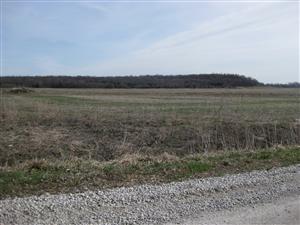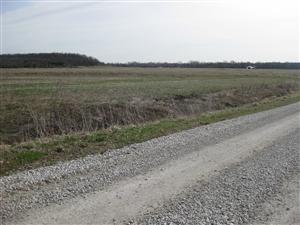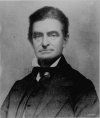The Pottawatomie Massacre
Tour Stop
Directions: The site of the Pottawatomie Massacre [ Waypoint = N38 27.315 W95 05.041 ] is located in Franklin County just north of Pottawatomie Creek and the town of Lane, Kansas 66042.
- Leaving Black Jack Park, turn left (north) on E 2000th Road, and then turn right (east) at N 200 Road/US Highway 56.
- After about 3 miles, turn right (south) at E 2300 Road/Kansas Highway 33.
- After about 10.4 miles, turn right (west) at Kansas Highway 68.
- After 1 mile, take the third left onto Vermont Road. After about 5 miles while you pass through Rantoul, Kansas, you may notice that the name of the road changes to N McGinnis Avenue. Once past Rantoul, the name of the road changes back to Vermont Road.
- About 11 miles after you initially turn onto Vermont Road, the road will bear to the east and change its name to Virginia Road.
- After about 1.2 miles, turn left (east) onto Douglas Terrace and find a place to park.

The events leading up to the Pottawatomie Massacre began back on May 21, 1856. A courier had arrived in Osawatomie, Kansas on bringing news of the pro-slavery attack on the free-state town of Lawrence, Kansas. Captain John Brown, Jr. immediately pulled together his Pottawatomie Rifles company of 50-60 men and started for Lawrence. When they reached Palmyra, Kansas, they met up with Captain Samuel T. Shore's company, from whom they heard about the Sack of Lawrence. Since the attack was over, Captain John Brown, Jr. decided to return to Osawatomie. However, old John Brown had other plans.

“I was personally acquainted with the Doyals, Wilkinsons & Sherman; and I am fully satisfied , as every body else is who lived on the Creek in '56; that a base conspiracy was on foot to drive out, burn, and kill: - in a word the Pottawatomie Creek from its mouth to its founded head was to be cleared of every man, woman, or child who was for Kansas being a free state.”
 John Brown's group including four of his sons, Frederick, Oliver, Owen and Watson, his son-in-law, Henry Thompson, Theodore Weiner and James Townsley. That evening, according to Townsley, “When within two or three miles of Pottawatomie creek, we turned off the road to the right, drove down into the edge of the timber between two deep ravines and camped about one mile above Dutch Henry's crossing.”
John Brown's group including four of his sons, Frederick, Oliver, Owen and Watson, his son-in-law, Henry Thompson, Theodore Weiner and James Townsley. That evening, according to Townsley, “When within two or three miles of Pottawatomie creek, we turned off the road to the right, drove down into the edge of the timber between two deep ravines and camped about one mile above Dutch Henry's crossing.”
Old John Brown was familiar with the area. In 1855, five of his sons had emigrated to the Kansas Territory and settled on the north side of Pottawatomie Creek about two miles southwest of the present day town of Lane, Kansas 66042. After the men had eaten supper, John Brown revealed his plans for that night. James Townley later gave this eyewitness account:
“[John Brown] said he wanted me to pilot the company up to the forks of the creek some five or six miles above, into the neighborhood in which I lived, and show them where all the Pro-slavery men resided; that he proposed to sweep the creek as he came down of all the Pro-slavery men living on it.”
After dark on May 24th, John Brown ordered his group to move out from their camp. After crossing Mosquito Creek, they came to a cabin that was the home of James P. Doyle, a pro-slavery settler. Old Brown went to the door of the cabin with his sons, Owen, Oliver and Watson, and his son-in-law, Henry Thompson. According to Townsley's eyewitness account:
“The old man Doyle and two sons were called out and marched some distance from the house toward Dutch Henry's in the road, where a halt was made. Old John Brown drew his revolver and shot the old man Doyle in the forehead, and the two youngest sons immediately fell upon the younger Doyle with their short two-edged swords. One of the young Doyle was stricken down in an instant, but the other attempted to escape, and was pursued a short distance by his assailant and cut down.”
Next they moved down Mosquito Creek to the cabin of Allen Wilkinson. Wilkinson was a pro-slavery candidate who had been elected to the Territorial Legislature in March of 1855. Again, according to the eyewitness account of James Townsley:
“Here the old man Brown, three of his sons and son-in-law, as at the Doyle residence, went to the door and ordered Wilkinson to come out, leaving Frederick Brown, Winer and myself standing in the road east of the house. Wilkinson was taken, marched some distance south of the house, and slain in the road with a short sword by one of the younger Browns. After he was killed his body was dragged out to one side and left.”
Next they went after the Shermans, which meant crossing Pottawatomie Creek. James Townley in his eyewitness account related the following:
“Here John Brown and the party, excepting Frederick Brown, Winer and myself, who were left outside a short distance from the door, went into the house and brought out one or two persons, talked with them some, and then took them in again. They afterward brought out Wm. Sherman, Dutch henry's brother, and marched him into Pottawatomie creek, where he was slain with swords by Brown's two youngest sons, and left lying in the road. … It was the expressed intention of Brown to execute Dutch henry also, but he was not found at home. He also hoped to find George Wilson, Probate Judge of Anderson co., there, and intended, if he did, to kill him too. Wilson had been notifying Free State men to leave the Territory. I had received such a notice from him myself.”
It was now after midnight on May 25th and the they returned to their camp site to the west along Pottawatomie Creek.
There was always a controversy as to whether old John Brown was directly involved in the Pottawatomie Massacre and whether he had done any of the killing. John Brown, himself, later was quoted as saying the following:
“I did not [commit the murders]; but I do not pretend to say that they were not killed by my order, and in doing so I believe I was doing God's service.”
But James Townley's account and revelations in a letter from James Hanway to James Redpath seem conclusive that John Brown was directly involved. Hanway was a friend and follower of John Brown during Bleeding Kansas. In the letter, Hanway tries to correct Redpath's contention that Brown had not been directly involved in the murder of the pro-slavery men. James Redpath was a newspaper man, had known Brown in Kansas, and had published a book in 1860 called The Public Life of Capt. John Brown.
“Now sir, what I am going to relate to you, I have never mentioned to but one man living. And that is, one of the party made a proposition to me to win the company, and also gave me such information in regard to their contemplated enterprise as to satisfy my mind that they were the chief actors in the Pottawatomie tragedy.”
“The description of the dress of the 'old man who appeared to be leader' was described by Mrs.W[ilkinson] & by other women & men at Shermans. All I have to say is, that it agreeded precisely to that worn by John Brown Sr. Of this, there is no doubt.”
In the letter, Hanway would relay the following conversation he had with old John Brown in 1858:
“[John Brown] asked me 'how do the people on the Creek regard the killing of the Shermans etc at this time.' My remark was, that I did not know a settler of 56, but what regarded it as amongst the most fortunate events in the history of Kansas - that this event saved the lives of the free state men on the creek: that those who did the act were looked upon our deliverers. The old man remarked, that the first shock frightened the free state men, almost as bad as the ruffians, but he knew when the facts were understood that a reaction would take place. He then remarked that 'if the killing of these men was murder, then he was an accessory.' … This remark did not surprise me, because I heard his brother in law, Revd Mr. Adair say that the old man had said the same to him.”
